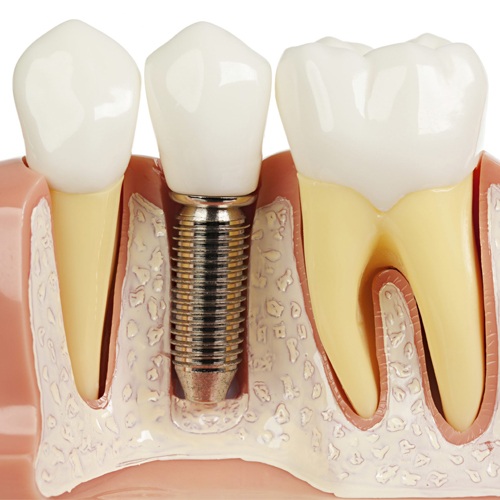Dental implants in Türkiye
Dental implants were invented in 1952 by Swedish orthopedic surgeon “Per-Ingvar Brånemark” and over the years technology and science have advanced to combine to dramatically improve the results of dental implants.
Today, the success rate for dental implants is 98%.
The goal of replacing teeth in dentistry is divided into two parts, the first in the functional aspect and the second in the aesthetic aspect.
In general, an implant is a surgical tool that is placed in the jawbone and left to fuse with the bone over a period of a few months. Where the implant is considered a replacement for the root of the missing tooth, but in an artificial way, and a replacement tooth or bridge is attached to it.
The dental implant fused with the jaw bone “osseointegration” is the closest thing to imitating natural teeth, because it stands on its own without affecting the adjacent teeth and has great stability.
Most dental implants are now made of titanium, allowing them to fuse with bone without being considered by the body as a foreign body.
Why do you need dental implants?

Dental implants can be used to replace one tooth, multiple teeth, or all teeth.
There are three options for tooth replacement:
- Full denture or removable partial denture
- Fixed (supported) dental bridge
- Dental implants.
Dentures are the least expensive option to replace teeth, but many people do not want them due to the discomforts in the mouth. Furthermore, dentures can affect the sensory sense of taste with food.
As for dental bridges, they were the most common restorative option before the recent and increasing shift to dental implants, but their main disadvantage lies in their dependence on existing natural teeth for support while compared to implants.
The latter is supported by bone only and does not affect the surrounding natural teeth.
Choosing an option depends on many factors, including:
- The location of the missing tooth or teeth.
- The quantity and quality of the jawbone where the dental implant will be placed.
- patient health.
- Cost and patient preferences.
The dental surgeon examines the area where the procedure will be performed and takes it into consideration when performing dental implants
He also performs a clinical assessment of whether the patient is a good candidate for dental implants.
In choosing the option of dental implants to replace teeth, there are many advantages, the most important of which is the ability to replace missing teeth without affecting or changing the adjacent teeth.
In addition to their integration with the bone structure, they are very stable and can have the look and feel of natural teeth.
What are the types of dental implants? Why is it used?
There are two different types of dental implants:
- Intraosseous implant.
- Subperiosteal implant.
However, subperiosteal implants are no longer used today due to their poor long-term results compared to intraosseous dental implants.
Due to their stability, dental implants can be used to support removable dentures and provide a more secure and comfortable fit.
For orthodontic procedures, dental mini-implants can act as temporary retainer devices (TADs) to help straighten teeth
To the desired position, these implants are small and temporarily attached to the bone and help stabilize the movement of the teeth, and they are removed after performing their job.
When patients lose all their teeth, whether due to decay or gum disease, the “All-On-4” technique can be resorted to. This technique derives its name from the idea that four implants can be used to replace all the teeth in one bracket (upper or lower) and the implants are placed Strategically placed in areas with good strong bone and a thin prosthesis is held in place.
The All-On-4 technology provides a fixed (non-removable) tooth replacement.
Consultation and planning stage
The dental surgeon will visually check the site in the mouth as well as look at the results of dental imaging (X-rays, panoramic films and/or CT scans).
Through a series of examinations, the quality and quantity of the jaw bone is evaluated to determine if there is a need for more bone in the site. Once it is confirmed that the dental implant can be placed in the desired location, the patient returns for dental implant surgeries.
Before proceeding with the procedures, a local anesthetic is given to numb the surgical area in addition to any other sedatives needed for comfort and anxiety.
The first stage
The first stage of oral surgery includes tooth extraction, because in many cases there are damaged teeth at the place of implantation
An artificial bone will then be placed to achieve a solid bone base for the implant and will be left to heal for two to six months.
As for the site in which there is no loss of teeth and bone, it requires a different bone graft that is placed over the existing jawbone, but this procedure is more complex and requires, like its predecessor, six months or more of healing.
There are cases in which there is a sufficient amount of bone, at which time the damaged tooth can be extracted, then the implant is implanted at the same time, and this is termed as “immediate implantation”.
In the case where the implant is placed in the upper jaw (maxillary) the available amount of bone may be limited due to the presence of the maxillary sinus (air-filled space present in the facial bones) then a “sinus augmentation” or “sinus lift” is performed to raise the floor sinuses and grafting more bone into the sinuses.
This will provide more bone to support the dental implant.
After ensuring that there is sufficient, strong bone, the site is ready for implantation.
The second phase
Then the procedure of placing the dental implant in the bone begins, and a drill and special tools are used in this, and after placing it, it is covered with a special cover, then the gums are sutured, and the healing stage begins. Temporary dentures can be placed and used to replace missing teeth for cosmetic purposes during the healing phase, which depends in time on the quality of the existing bone. In general, recovery requires two to six months, and during this time the implant fuses with the bone, so it is important to avoid putting any force or pressure on the dental implant. during her recovery.
The implant is then confirmed to successfully fuse with the surrounding bone and then followed by attaching a prosthetic component to the dental implant via a screw.
This component is called an abutment on which the replacement tooth or crown is placed and the latter is made to order.
What are the risks, complications, and potential problems with dental implants?
There is no surgery without risks…! Of course, dental implants, like other operations, involve potential risks and complications for the patient
However, careful planning is important to ensure that the patient is healthy enough to undergo oral surgery and recover properly.
Fortunately, the success rate is very high and failures usually occur in the event of an unlikely infection, dental implant breakage,
Excessive load on dental implants, damage to the surrounding area (nerves, blood vessels, and teeth), poor placement of dental implants, or poor amount or quality of bone.
Is the dental implant process painful?
- Dental implant surgery is usually performed under local anesthesia, so you should not feel any pain during the procedure.
- After the local anesthetic wears off, post-surgical discomfort will vary on a case-by-case basis.
- Most people feel uncomfortable during the procedure.
- A cold ice pack is placed on the skin over the surgical area after treatment to help reduce swelling.
- Pain can be controlled with over-the-counter pain relievers such as ibuprofen or acetaminophen.
- More invasive surgery may require a stronger prescription for pain management and a longer recovery time.
- Aside from pain relievers, prescriptions for antibiotics and mouthwash may be needed to support the healing of the area over the next few weeks.
How can I book for in Türkiye?

- Free medical support on the phone: You will have a dedicated representative for your health condition who is always ready to answer your questions.
- Free consultation with a specialist doctor: Your medical representative will consult with a number of doctors and hospitals to find the best possible treatments.
- Free travel visa arrangement: We will contact the embassy in your country to assist you in obtaining a visa to visit Türkiye.
- Free itinerary planning: We will create a schedule for your medical trip to Türkiye.
- Free translation of documents and reports: We will translate medical documents and reports into Turkish on your behalf.
- Free support and monitoring: We will monitor the stages of treatment and be by your side every step of the way.
- Free instant translation: We will be with you during the treatment stages to provide translation between you and the medical team.
- Free accommodation and transportation coordination: We will book accommodation for you and your companions in Türkiye, along with transportation services.
Contact REHABTÜRK doctors for more information about the procedure and to evaluate your medical condition.
